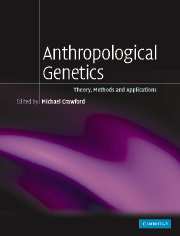Book contents
- Frontmatter
- Contents
- List of Contributors
- Preface
- Chapter 1 Foundations of Anthropological Genetics
- Part 1 Theory
- Part 2 Methods
- Chapter 4 The Importance of Field Research in Anthropological Genetics: Methods, Experiences and Results
- Chapter 5 The Confluence of Anthropological Genetics and Anthropological Demography
- Chapter 6 Molecular Markers in Anthropological Genetic Studies
- Chapter 7 The Use of Quantitative Traits in Anthropological Genetic Studies of Population Structure and History
- Chapter 8 Ancient DNA and its Application to the Reconstruction of Human Evolution and History
- Part 3 General Applications
- Part 4 Part IV The Human Diaspora
- Index
- References
Chapter 6 - Molecular Markers in Anthropological Genetic Studies
Published online by Cambridge University Press: 05 June 2012
- Frontmatter
- Contents
- List of Contributors
- Preface
- Chapter 1 Foundations of Anthropological Genetics
- Part 1 Theory
- Part 2 Methods
- Chapter 4 The Importance of Field Research in Anthropological Genetics: Methods, Experiences and Results
- Chapter 5 The Confluence of Anthropological Genetics and Anthropological Demography
- Chapter 6 Molecular Markers in Anthropological Genetic Studies
- Chapter 7 The Use of Quantitative Traits in Anthropological Genetic Studies of Population Structure and History
- Chapter 8 Ancient DNA and its Application to the Reconstruction of Human Evolution and History
- Part 3 General Applications
- Part 4 Part IV The Human Diaspora
- Index
- References
Summary
Introduction
In 1973, a chapter entitled ‘The use of genetic markers of the blood in the study of the evolution of human populations’, was published in the first volume that attempted to synthesize the field of anthropological genetics (Crawford, 1973). This chapter defined genetic markers as "discrete segregating, genetic traits which can be used to characterize populations by virtue of their presence, absence, or high frequency in some populations and low frequency in others' (Crawford, 1973: 38). This definition similarly applies to molecular markers, which are segregating regions of DNA, present in some populations but absent or infrequent in others. The 1973 chapter summarized the available genetic markers of the blood that could be used for the measurement of evolutionary processes and the characterization of human population structure. The list of available polymorphic loci included 16 blood groups, 11 red blood cell proteins, 10 serum proteins and 3 white cell and platelet systems. These ‘riches’ of available variation of the blood followed 70 years of research on the blood group systems (since Karl Landsteiner's original work in 1900), and Oliver Smithies (1955) development of zone electrophoresis for the separation of specific proteins from mixtures such as the serum of the blood (Landsteiner and Levine, 1927). At the time the first volume in anthropological genetics was compiled, the physiological functions of blood groups were unknown, other than their involvement in blood transfusion and some suspect statistical associations with disease.
- Type
- Chapter
- Information
- Anthropological GeneticsTheory, Methods and Applications, pp. 141 - 186Publisher: Cambridge University PressPrint publication year: 2006
References
- 6
- Cited by



